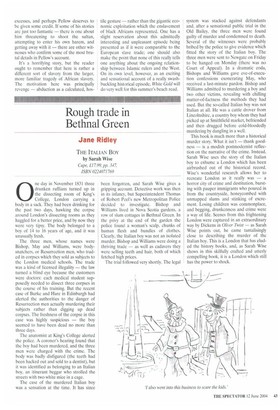Rough trade in Bethnal Green
Jane Ridley
THE ITALIAN BoY by Sarah Wise Cape, f17.99, pp. 347, ISBN 0224071769 0 ne day in November 1831 three drunken ruffians turned up in the dissecting room of King's College, London carrying a body in a sack. They had been drinking for the past two days, hawking the corpse around London's dissecting rooms as they haggled for a better price, and by now they were very tipsy. The body belonged to a boy of 14 to 16 years of age, and it was unusually fresh.
The three men, whose names were Bishop, May and Williams, were bodysnatchers, or Resurrection men, who traded in corpses which they sold as subjects to the London medical schools. The trade was a kind of licensed illegality — the law turned a blind eye because the customers were doctors: each medical student supposedly needed to dissect three corpses in the course of his training. But the recent case of Burke and Hare in Edinburgh had alerted the authorities to the danger of Resurrection men actually murdering their subjects rather than digging up dead corpses. The freshness of the corpse in this case was highly suspicious — the boy seemed to have been dead no more than three days.
The anatomist at King's College alerted the police. A coroner's hearing found that the boy had been murdered, and the three men were charged with the crime. The body was badly disfigured (the teeth had been hacked out and sold to a dentist), but it was identified as belonging to an Italian boy, an itinerant beggar who strolled the streets with two white mice in a cage.
The case of the murdered Italian boy was a sensation at the time. It has since been forgotten, and Sarah Wise gives a gripping account. Detective work was then in its infancy, but Superintendent Thomas of Robert Peel's new Metropolitan Police decided to investigate. Bishop and Williams lived in Nova Scotia gardens, a row of slum cottages in Bethnal Green. In the privy at the end of the garden the police found a woman's scalp, chunks of human flesh and bundles of clothes. Clearly, the Italian boy was not an isolated murder, Bishop and Williams were doing a thriving trade — as well as cadavers they were selling teeth and hair, both of which fetched high prices.
The trial followed very shortly. The legal
system was stacked against defendants and, after a sensational public trial in the Old Bailey, the three men were found guilty of murder and condemned to death. Several of the witnesses were probably bribed by the police to give evidence which fitted the story of the Italian boy. The three men were sent to Newgate on Friday to be hanged on Monday (there was no Court of Appeal). In a dramatic coda, Bishops and Williams gave eve-of-execution confessions exonerating May, who received a last-minute pardon. Bishop and Williams admitted to murdering a boy and two other victims, revealing with chilling matter-of-factness the methods they had used. But the so-called Italian boy was not Italian at all. He was a cattle drover from Lincolnshire, a country boy whom they had picked up at Smithfield market, befriended and then drugged before cold-bloodedly murdering by dangling in a well.
This book is much more than a historical murder story. What it isn't — thank goodness — is a modish postmodernist reflection on the narrative of the crime. Instead, Sarah Wise uses the story of the Italian boy to exhume a London which has been airbrushed out of the historical record. Wise's wonderful research allows her to recreate London as it really was — a horror city of crime and destitution, bursting with pauper immigrants who poured in from the countryside, honeycombed with unmapped slums and stinking of excrement. Losing children was commonplace, and begging, drunkenness and crime were a way of life. Scenes from this frightening London were captured in an extraordinary way by Dickens in Oliver Twist — as Sarah Wise points out, he came tantalisingly close to describing the murder of the Italian boy. This is a London that has eluded the history books, and, as Sarah Wise shows in this skilfully crafted and utterly compelling book, it is a London which still has the power to shock.


















































































 Previous page
Previous page